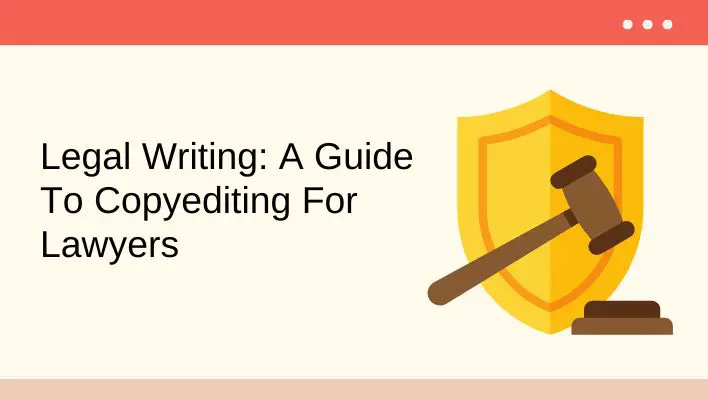If you’re a lawyer, editor, or writer of any sort, you’ve probably noticed that some people are better at writing than others. The same is true for editing. So how can we make sure our writing is as good as it can be? Here’s a guide to copyediting for lawyers:
| Key Takeaways |
|---|
| 1. Copyediting is essential for polished legal writing. |
| 2. Clarity and precision are paramount in legal documents. |
| 3. Anecdotes and storytelling can humanize legal content. |
| 4. Effective legal guidance requires strategic structuring. |
| 5. Mastering persuasive writing techniques is valuable. |
| 6. Legal research guides aid in comprehensive writing. |
| 7. Writing to persuade involves understanding rhetoric. |
| 8. Proofreading ensures accuracy and professionalism. |
| 9. Legal memoranda should convey complex concepts concisely. |
| 10. Crafting engaging titles can enhance reader interest. |
Capitalization
Capitalization is one of the most common mistakes made by lawyers, both in their writing and in their drafting of contracts. The capitalization rules are not difficult to remember, and the only way you could get confused about them is if you were looking at a document whose author was unaware of them (and thus didn’t capitalize properly).
To begin with, capitalize the first word of every sentence. Don’t worry about what constitutes a sentence; just write them as they come to mind.
And don’t worry about how many words there are in your sentences; this isn’t an SAT prep test! Capitalize proper nouns, including names of people (for example Jane Doe), places (for example New York City), and things (for example my dog). You can also capitalize pronouns that refer back to these proper nouns so “I” would be capitalized, but “he” would not be.
The same rule applies when quoting someone else’s words; if they start with a capital letter, then yours should as well. If someone says something like “I’m going home,” then your next line should read: “Jane said she was going home.” Capitalizing this word ensures it stands out from its surrounding text better than if it were lowercased or left uncapitalized altogether
When aiming to persuade through legal writing, understanding the nuances of rhetoric is crucial. Explore our comprehensive guide on writing to persuade and discover techniques that can enhance your persuasive communication skills in the legal domain.
Abbreviations And Acronyms
When you use an abbreviation or acronym, use the shortest possible form.
Use periods rather than spaces to separate the letters in an abbreviation or acronym. For example, write “U.S.” or “NCAA,” not “US” or “NCAA.”
Use periods between all of the letters in an abbreviation or acronym except for the last one, which should be followed by a comma if it’s part of a sentence (e.g., “During practice, I ran six miles with my team.”). Don’t capitalize any parts of this type of abbreviated reference (so don’t write “Mr.”, even if it would be capitalized normally).
Italics, Quotation Marks, And Boldface
You should italicize the titles of books and magazines, as well as the names of ships, aircraft, and other vehicles. You also use italics for song titles and poems, as well as for long quotations within a sentence.
You should use quotation marks for short quotes within a sentence (or sometimes just to indicate that words are being spoken aloud by an actor). They can also be used around idiomatic expressions such as “the cat’s meow” or “dead ringer” that have become common usage but still retain their original meaning.
Boldface is used to emphasize words or phrases within the text; it isn’t just reserved for headings.
Aspiring student attorneys can greatly benefit from well-structured legal research guides. Our collection of legal research guides provides valuable insights and methods to navigate complex legal landscapes, empowering you to excel in your legal studies.
Numbers
You want to make it clear to your reader that you know what you’re talking about. The best way to do this is by using numerals for all numbers 10 and above, as well as for any numbers in the titles of books, plays, movies, etc.
You can also use numerals when writing about articles for example: “This article explores how the legal system treats victims differently based on their gender identity.”
Dates And Times
The standard format for dates and times is the day, month, and year. For example Oct. 10, 2020, or Sept. 23, 2022.
However, there are alternative formats that may be used as well; these three are date examples in each of the three alternate formats:
Oct 10, 2020 (month, day)
Sep 23, 2022 (day month)
Sep 2022 (year month day)
Hyphenation
The hyphen is a type of punctuation mark used to join words and to separate syllables in a word.
It consists of two straight lines, one solid and the other broken, which cross at an angle. The word “hyphen” comes from the Greek ὑφᾱνής (hyphainés), meaning “under one” or “in union with.” In English, this mark is sometimes called a dash or en dash.
Crafting a compelling legal memorandum demands precision and clarity. Learn the art of constructing effective legal memoranda from our guide on how to write a legal memorandum, and refine your ability to convey complex legal concepts with conciseness.
Punctuation (And Other Typographic Marks)
Punctuation and other typographic marks are what make your writing look polished and professional. Here’s a quick review of the most common ones:
- periods (.), commas (,), semicolons (;), parentheses/brackets ()
- quotation marks (“”), apostrophes (‘), question marks [?] and exclamation points [!]
- colons: semicolons ;
Underlining
Underlining is used in non-legal writing to emphasize text. In legal writing, it’s a no-no. The underlined word should be bolded instead of underlined when you want to emphasize it.
The reason for this is that underlining implies that the content is important enough to highlight; however, titles and headings are already supposed to be emphasized by being in larger type or italics (or both). If you need more emphasis on them than they already have, use boldface instead of underlining.
Alternative Forms Of Punctuation In The U.S. Constitution And Other Legal Documents
When you’re writing your legal documents, you’ll want to consider alternative forms of punctuation that are used in the U.S. Constitution and other legal documents.
Hyphens are used to break up words or phrases to avoid confusion. For example, “The term ‘spaced out’ could be interpreted as an adjective or a verb.” (Note: The hyphenated phrase “spaced-out” is usually read with a space.)
Hyphens can also be used when referring to multiple authors; for instance, if two different people work on a project together, they might collaborate on it using their initials John Smith-Jones and Mary Smith-Johnson but they would both be listed as coauthors in the resulting paper or book because there’s only one publication credit line.
At the end of each chapter; instead of saying “John Smith-Jones and Mary Smith-Johnson,” the publication would say something like “John Smith-Jones and Mary Smith-Johnson” followed by their names in parentheses.
Ellipses indicate that part of an idea has been left off but may be implied by context clues elsewhere within speech or writing (or both). For example:
“I’m excited about our plans for next year!” said my friend enthusiastically after I told him about all our exciting new projects ahead.
Anecdotes can be powerful tools in legal writing, adding a human element to complex cases. Delve into the world of storytelling with our guide on how to write an anecdote, and master the art of incorporating engaging narratives into your legal documents.
Measurements, Terms Of Money, And Units Of Time
Use a space between the number and the unit of measurement; this includes kilometers (5 km) and pounds (10 lbs.). Do not use a hyphen in these cases:
- 5 km
- 10 lbs.
Crafting legal guidance that effectively assists and informs requires a nuanced approach. Uncover 17 invaluable hints for creating effective legal guidance that resonates with your intended audience, ensuring your communication is impactful and comprehensive.
Conclusion
I hope this guide has helped you understand how to use the rules of capitalization, abbreviation and acronym, italics, boldface, and underlining. I also hope that it will help you avoid some common mistakes in formatting your writing so that it is more readable.
Further Reading
Proofreading and Editing Legal Writing: Explore additional insights on refining your legal writing through effective proofreading and editing practices.
10 Tips from Legal Writing Experts: Learn from the expertise of legal writing professionals with these 10 valuable tips to enhance your legal writing skills.
Legal Writing, Editing, Proofreading, and More: Gain a broader perspective on legal writing, editing, and proofreading with articles covering various aspects of the process.
And here’s the “FAQs” section:
FAQs
What are the key elements of effective legal writing?
Effective legal writing involves clarity, precision, and logical organization. It should concisely convey complex legal concepts while engaging the reader.
How can I improve my legal writing skills?
Improving legal writing skills requires practice, feedback, and continuous learning. Consider seeking guidance from experts, attending workshops, and reading reputable resources.
What role does proofreading play in legal writing?
Proofreading ensures accuracy by catching grammatical errors, typos, and formatting mistakes. It’s a crucial step in presenting polished and professional legal documents.
Where can I find expert advice on legal writing?
You can find expert advice on legal writing from reputable sources such as legal blogs, bar associations, and publications dedicated to legal professionals.
How can legal writing impact my professional success?
Well-crafted legal writing can enhance your credibility, facilitate effective communication with clients and colleagues, and contribute to successful legal outcomes.

Costantine Edward is a digital marketing expert, freelance writer, and entrepreneur who helps people attain financial freedom. I’ve been working in marketing since I was 18 years old and have managed to build a successful career doing what I love.
